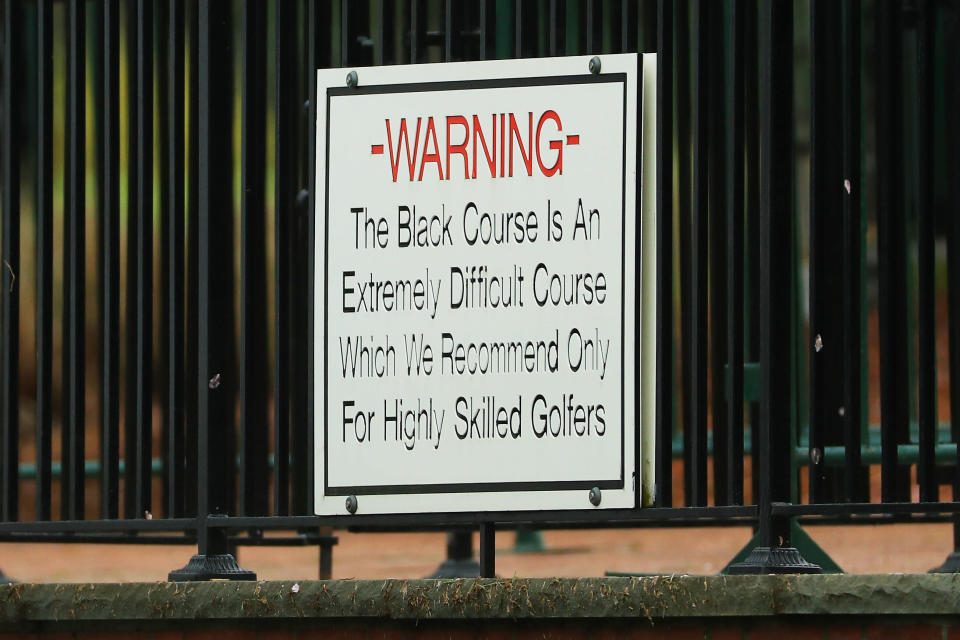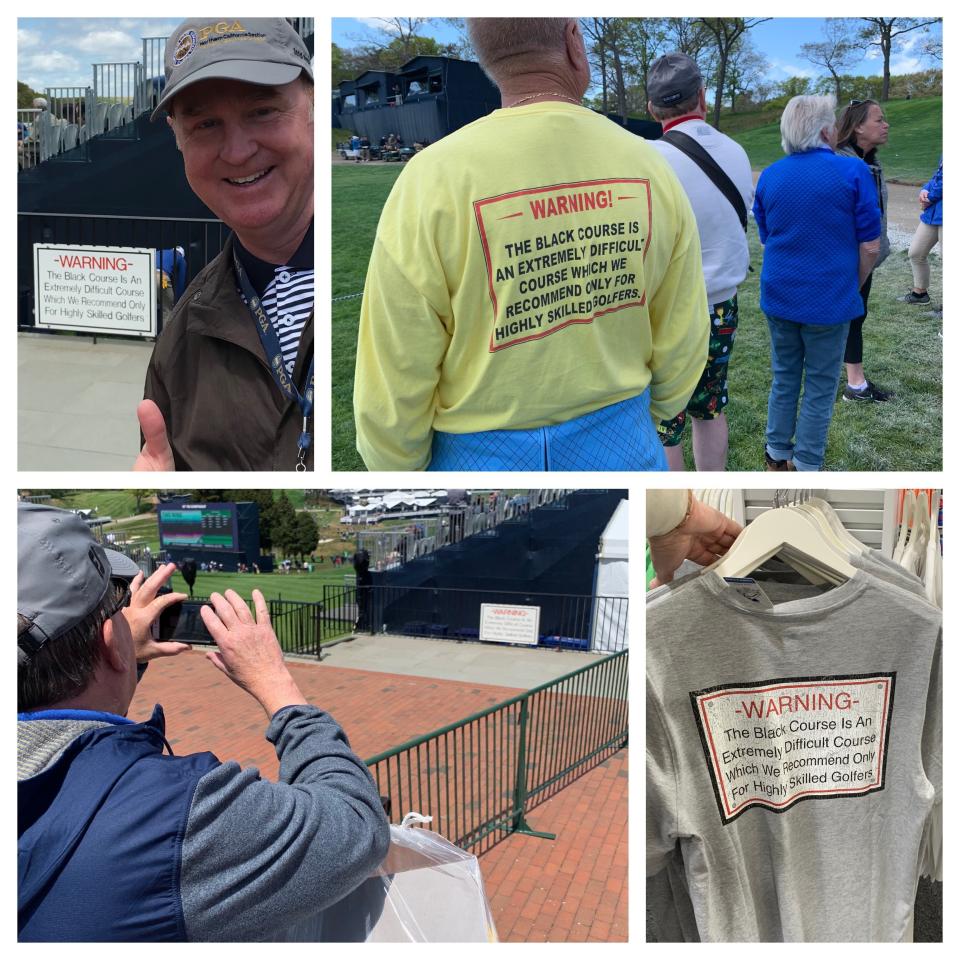Bethpage Black and the most famous sign in golf
FARMINGDALE, N.Y. — Most of golf’s most photographed locations were cut for millions of years by glaciers, laid out by long-dead Scotsmen or bordered by seas and oceans.
Sometimes they’re a combination of all three.
The most photographed location at Bethpage Black, however, contains no trees, water or any of the 18 natural greens that were laid out where God dropped them. It is instead just a simple metal sign that’s bolted to an iron railing overlooking the first tee. It contains only 17 words, all of which are now easily repeated like an oath or prayer by diehard fans of the sport.
-WARNING- The Black Course Is An Extremely Difficult Course Which We Recommend Only For Highly Skilled Golfers.
It’s a sign more befitting a ski slope and, in a way, it makes sense given the steep hills that define the challenge of this course. Yet it stands warning for every Joe Duffer that shells out between $75 (New York residents) and $150 (out-of-staters) on the weekends when the world’s best golfers aren’t using it to compete for an $11 million purse.
In the process, Bethpage’s sign has become an equal to Augusta’s Magnolia Lane, the bridge on the Old Course of St. Andrews or the island green at TPC Sawgrass.
“I have to imagine that every person who comes out to play this course takes a picture with this sign,” said Ed Winiecki, who was having his own picture taken during Wednesday’s practice rounds at this week’s PGA Championship.
Winiecki is a PGA professional from northern California and has sought out other famous locales to have his picture taken wherever he’s played or watched golf. He said a favorite is his recreation of the famous shot of Jack Nicklaus sitting on a fence above the Pacific Ocean just before teeing off on the 18th at Pebble Beach.
But to ask him on Wednesday afternoon, his shot with Bethpage’s famous sign is right up there. It was surely the same for the countless others who stopped their trek between the practice green and points beyond after recognizing the sign that became nationally famous when championship golf came to this state park with the 2002 U.S. Open.
The sign was featured consistently during that tournament — a Tiger Woods triumph, which only boosted the signal — and again seven years later when the event returned. Two ensuing FedEx Cup events, this week’s PGA Championship and the 2024 Ryder Cup only grow the sign’s status in the golf world.

“Take a picture of that,” instructed one fan to his friend in a thick New York accent. “It’s that famous sign.”
“That sign is not a joke,” advised another in the same accent. “My buddy’s a scratch golfer and this course absolutely ate him up.”
Though Bethpage Black is known as “The People’s Country Club,” the sign is not “The People’s Sign” — at least not this week. Metal barriers are being used to form a funnel for the pros to access the first tee from the practice green, meaning any selfie and posed photograph attempts have to be made at an awkward distance from about 15 yards.
That didn’t stop a steady stream of people from trying. One foursome from Canada said the sign played a big role in their decision to fly in for just Wednesday’s practice round.
The sign, they said, inferred a mystique on the course that they simply had to come check out in a way they wouldn’t be drawn to, say, other PGA venues like Bellerive or Valhalla.
“It’s a warning that makes sense once you look down the hill at that first fairway,” said Tosh Skalosky, who was attending the practice round with his sons Tosh Jr. and Sam. “You don’t really appreciate what the sign is trying to warn people about until you start walking up and down the hills out here.”
Skalosky’s best friend Bill Tillman also made the trip and made one suggestion. “I think the sign should be a lot bigger,” he said.
The sign, however, is impossible to miss on a trip out to Bethpage.
Go into the PGA Championship merchandise tent and the sign is plastered on anything they can fit it on, which is anything from beer coozies and shotglasses (both $7) to golf towels ($16) and putter covers ($38). You can buy a mini-replica of the sign for the 19th hole in your basement in either metal ($28) or wood ($38), all while you wear the sign on a hat in your choice of style — truckers ($30) or bucket ($36).
Out near the 18th fairway, Paul Zagorski of Connecticut wore a faded, yellow, long-sleeve t-shirt with the sign printed on the back. He’d bought it about 15 years ago on his first of two trips to play the course.
What he’d shoot?
“I don’t remember,” he said. “I didn’t break a hundred, I can tell you that.”

Bethpage Black is part of a 90-hole public layout — the largest government-owned golf facility in the country — and was opened in 1936. Yet despite a history that’s fairly well-chronicled, the origin of the sign remains in dispute.
Josh Berhow of Golf Magazine recently did a story in which he “interviewed current Bethpage superintendents, former superintendents, former parks directors, course designers, historians, coaches, former coaches, communication specialists, authors, bloggers, fellow journalists, as well as representatives from the Long Island Golf Association, the Metropolitan Golf Association, the United States Golf Association, the Long Island Studies Institute at Hofstra, the Nassau Players Club, even St. John’s University” about the birth of the sign.
He fielded claims that the sign showed up in the ‘60s, ‘70s and ‘80s but could not tab one answer the definitive one.
A column in the New York Post, meanwhile, gave the benefit of the doubt to Mike Asheroff, a former deputy director of state parks who also shared his story with Golf.
According to Asheroff, it was a Memorial Day in the early ‘80s when he got a call about an incident out on the course. A man was trying to teach his wife the game on the challenging course while a frustrated group of golfers stacked up behind them. The situation soon devolved into both parties shooting golf balls into the other and the husband and wife had to be escorted from the course by police.
“I turned to [my employee] at that point and said, ‘Give me a piece of paper,’ ” Asheroff told the Post this week. “I scribbled out the wording of the sign and said, ‘Get the sign shop to make this up and put it by the park register and if anybody wants to play golf on the Black, point it out to them.’ That’s how the sign got out there.”
If only he had thought to trademark that wording, of course.
In various rankings of the most difficult courses in America, the Black tends to come in around 5-7, with The Ocean Course at Kiawah (S.C.) usually ranking No. 1.
The funny thing about the Black is there was a time not so long ago when it wasn’t that popular to play. Prior to the rejuvenation of the course by Rees Jones in 1998 and the arrival of championship golf, the course had devolved in the minds of many into an overgrown challenge that wasn’t worth the slog.
But that’s all different now. Between its exposure on television and the appeal of paying less than the amount of a good dinner to play the same course that Tiger tamed, Bethpage Black is as popular as ever.
Plus, there’s that sign, growing more famous by the year, all while warning, teasing and drawing people to what lies ahead. Never underestimate the power of a good dare.
More from Yahoo Sports:

